The riding multi-purpose lawn mower market is expected to grow from USD 1,250 million in 2025 to USD 2,055.0 million by 2035, reflecting a CAGR of 5%. Peak-to-trough analysis examines periods of maximum and minimum growth within the market cycle, helping identify phases of rapid expansion and relative stabilization. From 2025 to 2028, the market experiences an early peak in growth as demand rises among commercial landscaping services, municipal maintenance programs, and high-end residential users. Adoption during this phase is driven by product efficiency, versatility, and increasing awareness of mechanized lawn care solutions, resulting in a strong upward momentum.
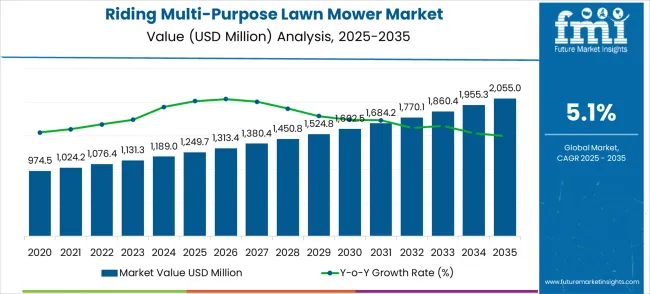
Following this initial surge, from 2028 to 2032, growth slows slightly, forming a trough as adoption saturates in established markets and incremental demand comes mainly from replacements and regional expansion. During this period, manufacturers focus on incremental product improvements, fuel efficiency, and operator comfort to maintain interest. From 2032 to 2035, growth picks up again as emerging markets adopt riding mowers, and technological innovations such as electric and hybrid models stimulate renewed demand. The peak-to-trough pattern highlights the cyclical nature of adoption, with early high growth, mid-phase stabilization, and later acceleration, providing stakeholders with insight to optimize production, distribution, and marketing strategies over the decade.
The riding multi-purpose lawn mower market is distributed across residential landscaping (40%), golf courses and sports grounds (26%), municipal and public parks (15%), commercial landscaping services (12%), and specialty applications such as botanical gardens and large estates (7%). Residential landscaping dominates demand due to growing interest in efficient, versatile lawn care solutions. Golf courses and sports grounds adopt riding mowers for precision turf maintenance and speed. Municipal parks and public spaces rely on them for large-scale upkeep, while commercial landscaping services use multi-purpose models for diverse client requirements. Specialty applications include estates and gardens where aesthetics and efficiency are key.
Key trends include battery-powered and hybrid riding mowers, modular attachments, and ergonomic operator features. Manufacturers are focusing on low-noise engines, fuel efficiency, and advanced cutting technologies. Expansion is driven by residential landscaping growth, sports facility maintenance, and eco-friendly lawn care initiatives. Collaborations between equipment producers and service providers enable customized solutions for performance, versatility, and operational efficiency, promoting steady global market growth.
| Metric | Value |
|---|---|
| Market Value (2025) | USD 1,250 million |
| Market Forecast Value (2035) | USD 2,055.0 million |
| Forecast CAGR (2025-2035) | 5% |
Market expansion enables property owners and landscape professionals to reduce maintenance time while improving lawn care quality through efficient equipment that covers large areas quickly. Suburban residential development creates consistent demand for lawn maintenance equipment capable of handling diverse terrain and landscape features across varying property sizes. Riding mowers provide operational efficiency for maintaining expansive lawns, parks, and commercial properties where walk-behind alternatives cannot deliver adequate productivity.
Residential homeowners drive primary demand through property development in suburban areas, requiring regular grass cutting and landscape maintenance. Meanwhile, commercial landscaping services utilize riding mowers for efficient grounds maintenance across schools, parks, and corporate facilities. A growing aging population seeks equipment that reduces physical exertion while maintaining lawn care standards. Equipment costs and seasonal demand patterns may limit market penetration in price-sensitive segments.
The market is segmented by product type, application, and region. By product type, the market is divided into front-mounted mowers, mid-mounted mowers, and others. By on application, the market is categorized into schools, residential areas, parks, and others. Regionally, the market is divided into North America, Latin America, Europe, East Asia, South Asia & Pacific, and Middle East & Africa.
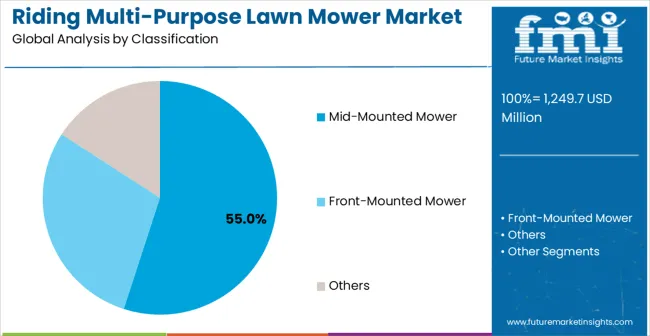
Mid-mounted riding mowers are projected to hold 55% of the global multi-purpose lawn mower market in 2025, driven by their superior cutting efficiency and maneuverability compared to other configurations. These mowers position the cutting deck centrally, providing optimal weight distribution that enhances stability and precise grass trimming across varied terrains, from flat lawns to slightly sloped surfaces. The mid-mounted design ensures improved operator visibility and control, allowing smooth navigation around trees, flower beds, and landscape features, which is particularly valued by residential users and commercial landscaping services.
Technological advancements in deck design improve grass cutting uniformity and discharge patterns, while versatile attachment options, including mulching systems, grass collectors, and snow removal implements, extend seasonal utility. Modern models often incorporate ergonomic seating, adjustable controls, and vibration reduction features to increase operator comfort during extended mowing sessions. The segment’s popularity is further reinforced by its adaptability, enabling operators to manage medium-to-large areas efficiently while maintaining professional-grade results, making mid-mounted mowers the preferred choice for diverse lawn care applications.
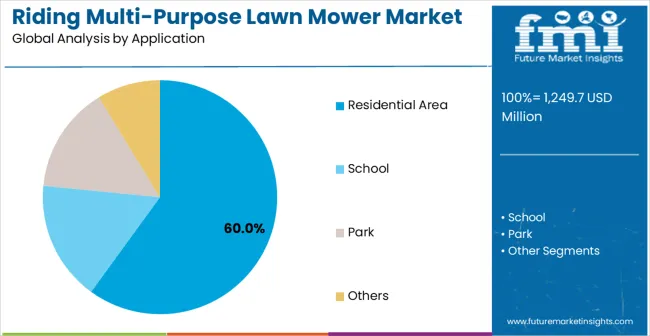
The residential area segment is expected to account for 60% of riding multi-purpose lawn mower demand in 2025, reflecting the increasing number of suburban homeowners requiring efficient and reliable lawn care solutions. Expansive lawns, complex landscaping designs, and property aesthetic standards drive the need for equipment capable of delivering professional-quality results with minimal effort. Mid- and front-mounted mowers with ergonomic controls, smooth transmission systems, and user-friendly interfaces are increasingly favored to meet these demands.
Residential users prioritize comfort, ease of operation, and low maintenance requirements, as these factors directly impact the convenience of routine lawn care. Growing suburban developments, coupled with rising property values, encourage investment in high-performance mowers that maintain the health and appearance of lawns. Seasonal demand and equipment replacement cycles ensure consistent market activity, while multifunctional models offering mowing, mulching, and leaf collection capabilities appeal to homeowners seeking comprehensive lawn management solutions. Consequently, residential lawns remain the primary driver of market growth, providing both volume demand and a stable foundation for technological innovation in riding multi-purpose lawn mowers.
The riding multi-purpose lawn mower market is experiencing significant growth driven by multiple factors. Rapid suburban residential development continues to create strong demand for efficient lawn maintenance equipment capable of handling expansive properties. Aging population demographics further accelerate adoption, as homeowners and landscape professionals increasingly prefer reduced-effort mowing solutions that minimize physical strain. The expansion of the commercial landscaping industry also fuels demand, as grounds maintenance operations require productive, versatile equipment that reduces labor hours while improving service quality. Rising labor costs in professional landscaping incentivize investment in high-performance riding mowers. Homeowners’ heightened property value awareness encourages the use of quality lawn care equipment that maintains landscape aesthetics and curb appeal. Additionally, seasonal weather patterns and extended growing seasons influence mower utilization rates and drive cyclical replacement cycles across different geographic regions.
The market growth is constrained by several factors. High acquisition costs of riding multi-purpose mowers impact consumer purchasing decisions and budget allocation, particularly for residential users. Seasonal demand fluctuations create inventory management challenges for manufacturers and dealers. Competition from robotic and autonomous mowing systems may slow the adoption of traditional riding mowers. Fuel price volatility affects operational expenses, and increasingly stringent emission regulations introduce compliance complexities that add to manufacturing costs. Storage limitations in residential properties and maintenance requirements demanding specialized technical expertise further restrict widespread adoption.
Key market trends highlight technological innovation and product evolution. Integration of electric propulsion systems enhances quiet operation, reduces emissions, and improves energy efficiency. Smart connectivity features enable remote monitoring, diagnostics, and operational optimization. Autonomous navigation systems support hands-free mowing, while ergonomic seating, vibration reduction, and operator comfort features enhance usability during prolonged sessions. Multi-functional capabilities expand through attachments supporting seasonal tasks such as leaf collection, snow removal, and utility transport, reflecting growing demand for versatile, green, and technologically advanced lawn care solutions.
The Riding Multi-Purpose Lawn Mower market (USD 1,249.7M → 2,055.0M by 2035, CAGR 5%) is shaped by rising landscaping demand across schools, residential areas, and parks, along with urban greenery expansion and mechanization of grounds maintenance. Growth is anchored in Asia-Pacific (China USD 6.9M, India USD 6.4M) and Europe (Germany USD 5.9M), while North America sustains mature adoption in professional lawn care and large-scale property management. Expanding adoption of both front- and mid-mounted mowers and increasing customization for diverse applications unlock ~USD 805M incremental opportunities by 2035.
Pathway A – Front-Mounted Mowers for Institutional Use
• Schools, sports complexes, and public grounds in India and China are driving large-scale adoption.
• John Deere and Kubota are positioned to benefit through government and institutional procurement.
• Largest pool: USD 300–320M
Pathway B – Mid-Mounted Mowers for Residential Areas
• Germany, USA, and UK see consistent uptake for residential landscaping and property management.
• Kubota, Toro, and Cub Cadet are leading innovation in ergonomic, efficient models.
• Opportunity pool: USD 180–200M
Pathway C – Specialty Mowers for Parks and Urban Green Spaces
• Brazil, UK, and Japan expanding investment in public parks and city beautification projects.
• Husqvarna, CNH Industrial, and STIHL targeting eco-friendly electric variants.
• Regional pool: USD 140–150M
Pathway D – Compact & Affordable Mowers for Emerging Markets
• Demand from smaller municipalities and semi-urban households in Asia-Pacific and Latin America.
• Local brands (LOVOL, LEO Group) scaling distribution networks.
• Expected pool: USD 90–100M
Pathway E – Smart & Sustainable Mower Solutions
• Integration of electric drives, IoT-enabled fleet management, and low-emission technologies.
• AGCO, Briggs & Stratton, and Snapper exploring AI-assisted mowing and autonomous solutions.
• Innovation pool: USD 70–80M
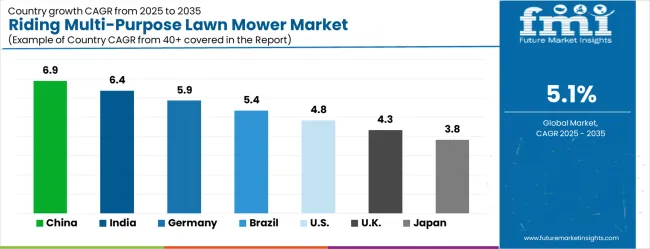
| Country | CAGR (2025-2035) |
|---|---|
| China | 6.9% |
| India | 6.4% |
| Germany | 5.9% |
| Brazil | 5.4% |
| United States | 4.8% |
| United Kingdom | 4.3% |
| Japan | 3.8% |
The riding multi-purpose lawn mower market is gathering pace worldwide, with China taking the lead thanks to rapid urbanization and expanding suburban development. Close behind, India benefits from growing middle-class prosperity and increasing property ownership, positioning itself as a strategic growth hub. Germany shows steady advancement, where precision engineering and quality manufacturing strengthen its role in the regional supply chain.
Brazil is sharpening focus on residential development and landscape maintenance services, signaling an ambition to capture niche opportunities. Meanwhile, the United States stands out for its established suburban infrastructure, and the United Kingdom and Japan continue to record consistent progress. Together, China and India anchor the global expansion story, while the rest build stability and diversity into the market's growth path.
The report covers an in-depth analysis of 40+ countries, Top-performing countries are highlighted below.
China is at the forefront of the riding multi-purpose lawn mower market, driven by suburban residential expansion, and increased middle-class prosperity. The country’s CAGR of 6.9% through 2035 is supported by government investment in urban green space development, parks, and landscaped residential communities, creating systematic demand for lawn maintenance equipment. Metropolitan areas such as Beijing, Shanghai, and Guangzhou serve as hubs for this growth, where developers incorporate landscape maintenance solutions into new residential projects. Domestic manufacturing capabilities support competitive pricing, ensuring access to mid- and high-end mowing equipment.
Additionally, Chinese manufacturers are integrating advanced features like ergonomic operator seating, multi-functional attachments for seasonal applications, and energy-efficient engines to cater to residential and commercial requirements. Public landscaping initiatives further support market expansion, including municipal parks and commercial landscapes. With rising awareness of property aesthetics and efficient lawn care practices, both individual homeowners and professional landscaping services increasingly adopt versatile, reliable mowers for large residential areas and public spaces.
India’s riding multi-purpose lawn mower market is growing steadily, supported by premium residential development and commercial property expansion in metropolitan areas such as Mumbai, Delhi, and Bangalore. With a projected CAGR of 6.4% through 2035, growth is driven by increasing middle-class income, expanding suburban housing, and rising awareness of lawn maintenance importance for property value enhancement.
Residential communities and commercial complexes are increasingly adopting multi-functional mowers that provide efficiency, precision, and reliability for large properties and landscaped grounds. Professional landscaping services also contribute to demand by requiring high-performance equipment capable of reducing labor and operational costs. Equipment with ergonomic designs, advanced cutting decks, and attachments for seasonal tasks, such as leaf collection or light snow removal, are increasingly favored. Manufacturers are responding with localized production facilities and technology adaptation to meet regional terrain and operational conditions, while premium international brands target high-end consumers seeking performance and innovation.
The riding multi-purpose lawn mower market in Germany is characterized by a focus on precision engineering, environmental compliance, and premium manufacturing quality. With a projected CAGR of 5.9% through 2035, demand is fueled by stringent emission regulations, energy efficiency standards, and high expectations for equipment durability in residential and commercial applications. Industrial centers such as Munich, Stuttgart, and Berlin serve as hubs for manufacturing advanced lawn care equipment. German manufacturers focus on engine efficiency, ergonomic designs, multi-functional attachments, and emission reduction technologies.
The market benefits from both domestic adoption and international exports of premium mowers. Government environmental initiatives encourage the development of hybrid and electric propulsion systems to meet environment goals. Additionally, Germany’s focus on operational efficiency and reduced maintenance requirements ensures that homeowners and professional landscapers adopt reliable and long-lasting equipment. Continuous product innovation and precision engineering reinforce Germany’s position as a technology leader in advanced lawn care solutions.
The riding multi-purpose lawn mower market in Brazil shows steady growth, driven by suburban residential development and increasing adoption of commercial landscaping services across São Paulo, Rio de Janeiro, and Brasília. Projected CAGR of 5.8% through 2035 is supported by property developers integrating landscape maintenance features into new housing projects and homeowners recognizing the importance of efficient lawn care for property aesthetics. Professional landscaping services contribute to market growth by adopting versatile and high-performance equipment to serve multiple clients efficiently.
Brazilian manufacturers provide mowers with advanced cutting deck technology, ergonomic seating, and multi-functional attachments for seasonal tasks such as leaf collection and light snow management. Awareness of property value and landscape aesthetics drives demand among individual homeowners and commercial facilities alike. Government support for urban green development and community landscape maintenance also contributes to equipment adoption. Manufacturers are increasingly focusing on energy-efficient engines and low-maintenance systems to meet operational and environmental standards.
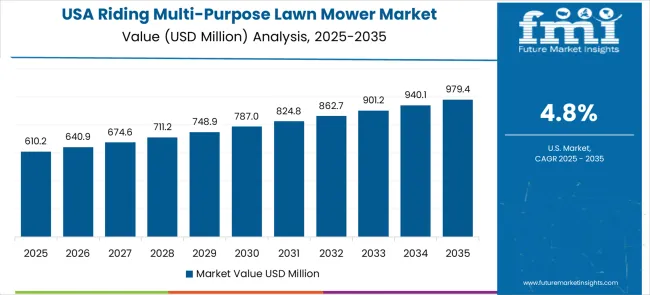
The USA riding multi-purpose lawn mower market benefits from an established suburban infrastructure and mature residential lawn care practices. With a projected CAGR of 4.8% through 2035, growth is driven by steady replacement cycles, technology upgrades, and consumer demand for advanced operational features. Homeowners and professional landscaping services prioritize equipment that combines ergonomic designs, smart connectivity, automated functions, and energy-efficient engines.
Smart mowers with GPS navigation, remote diagnostics, and automation capabilities are increasingly integrated, meeting consumer demand for convenience, precision, and reduced labor requirements. Replacement cycles and technological advancement in mid- and high-end equipment drive consistent market adoption. Manufacturers compete through innovation, performance enhancement, and reliable after-sales support. Seasonal weather patterns, large property sizes, and diverse terrains further support demand for versatile, multi-functional mowers.
The UK riding multi-purpose lawn mower market is shaped by environmental regulations, operational efficiency requirements, and growing residential and commercial landscaping demand. With a projected CAGR of 4.3% through 2035, demand is driven by adoption of low-emission, noise-compliant engines, and high-performance equipment. Homeowners and commercial landscaping services prioritize machines that deliver consistent cutting results, operational reliability, and energy efficiency. Multi-functional mowers with seasonal attachments provide flexibility for grass cutting, leaf collection, and minor snow removal. Strict emission and noise regulations encourage development of hybrid and electric alternatives while maintaining performance standards. Property aesthetics, green initiatives, and efficient operational capabilities further influence purchase decisions. Market growth is also supported by organized dealer networks and professional landscaping contractors adopting advanced equipment to maintain public and private landscapes.
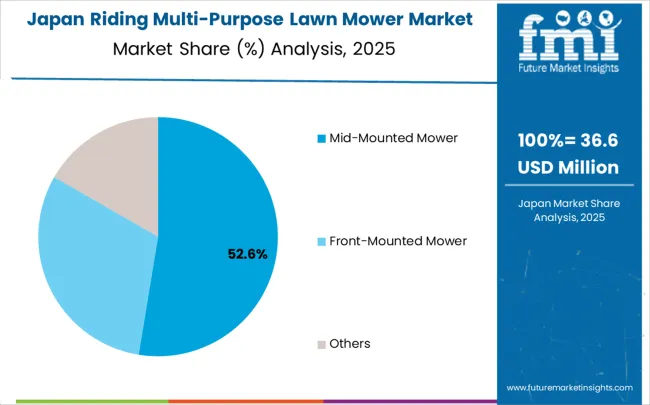
The riding multi-purpose lawn mower market in Japan focus on precision engineering, advanced manufacturing, and operational reliability. With a projected CAGR of 4.0% through 2035, growth is selective, targeting premium equipment that meets stringent performance, durability, and reliability standards. Homeowners and professional landscapers prioritize mowers with precise cutting capability, long-term operational stability, and ergonomic designs. Export opportunities for premium equipment also exist due to Japan’s reputation for engineering excellence. Consistent quality standards and operational reliability make Japanese products ideal for demanding residential and commercial applications where precision, performance, and low maintenance are critical.
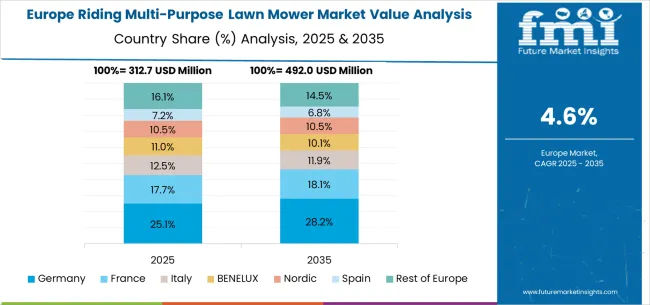
The European riding multi-purpose lawn mower market demonstrates coordinated development through regional environmental standards and technology advancement initiatives promoting equipment efficiency and emission reduction across diverse climate and terrain conditions. Germany maintains market leadership through precision engineering capabilities and advanced manufacturing processes that support both domestic residential markets and export opportunities within European Union markets. The United Kingdom contributes comprehensive environmental compliance frameworks and professional landscaping service development that influences regional equipment adoption patterns and operational standards.
France and Italy provide substantial markets for residential lawn care equipment through suburban development programs and landscape maintenance service expansion across residential and commercial properties. Nordic countries maintain unique requirements for equipment capable of operating effectively in challenging climate conditions while meeting environmental compliance standards. BENELUX region benefits from cross-border residential development coordination that promotes standardized equipment adoption and service support networks across integrated metropolitan areas.
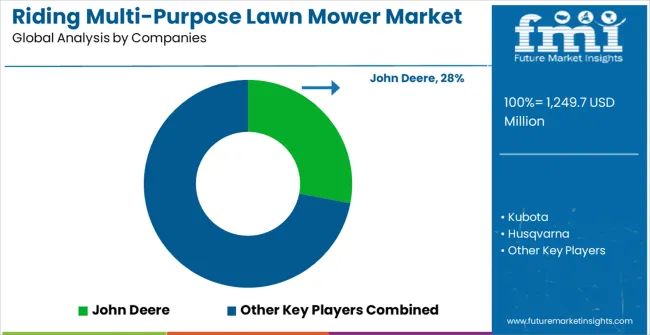
The riding multi-purpose lawn mower market features moderate concentration with approximately 20 meaningful players competing through product differentiation, technology innovation, and distribution network strength. Competition style prioritizes brand reputation, product reliability, and dealer service capabilities rather than price competition alone. Market structure reflects established agricultural equipment manufacturers leveraging lawn care market opportunities while specialized outdoor power equipment companies focus on residential and commercial landscaping applications.
Leaders including John Deere and Kubota maintain dominant positions through comprehensive product portfolios, established dealer networks, and brand recognition developed through agricultural equipment markets. These companies leverage manufacturing scale, research and development capabilities, and global distribution systems that enable consistent product availability and service support across diverse geographic markets. Strategic focus on technology integration, emission compliance, and product reliability enhancement that addresses evolving customer requirements and regulatory standards.
Challengers including Husqvarna and CNH Industrial compete through specialized product development and targeted market focus addressing specific customer segments and regional preferences. These companies focus on innovation in cutting technology, operator comfort features, and environmental compliance characteristics that differentiate their products from standard lawn care equipment. Competitive strategies focus on dealer relationship development and customer service excellence that builds brand loyalty and repeat purchase behavior across residential and commercial market segments.
Specialists including Toro, Cub Cadet, Briggs & Stratton, and emerging players like LOVOL serve focused market segments through specialized product configurations and targeted distribution strategies. These companies provide solutions for specific applications while maintaining flexibility in product development and customer service approaches that address unique regional or application-specific requirements not adequately served by larger manufacturers.
| Item | Value |
|---|---|
| Quantitative Units (2025) | USD 1,250 million |
| Product Type | Front-Mounted Mower, Mid-Mounted Mower, Others |
| Application | School, Residential Area, Park, Others |
| Regions Covered | North America, Latin America, Europe, East Asia, South Asia & Pacific, Middle East & Africa |
| Country Covered | United States, Canada, United Kingdom, Germany, France, China, Japan, South Korea, India, Brazil, Australia and 40+ countries |
| Key Companies Profiled | John Deere, Kubota, Husqvarna, CNH Industrial, Toro, Cub Cadet, Briggs & Stratton, Snapper, STIHL, LOVOL, AGCO, LEO Group |
| Additional Attributes | Dollar sales by product type and application categories, regional lawn care equipment demand trends across North America, Europe, and Asia-Pacific, competitive landscape with established agricultural equipment manufacturers and specialized outdoor power equipment providers, adoption patterns across residential and commercial landscaping applications, integration with smart connectivity systems and autonomous operation capabilities, innovations in electric propulsion technology |
How big is the riding multi-purpose lawn mower market in 2025?
The global riding multi-purpose lawn mower market is valued at USD 1,250 million in 2025.
What will be the size of riding multi-purpose lawn mower market in 2035?
The size for the riding multi-purpose lawn mower market is projected to reach USD 2,055.0 million by 2035.
How much will be the riding multi-purpose lawn mower market growth between 2025 and 2035?
The riding multi-purpose lawn mower market is expected to grow at a 5% CAGR between 2025 and 2035.
What are the key product type segments in the riding multi-purpose lawn mower market?
The key product type segments in the riding multi-purpose lawn mower market are front-mounted mower, mid-mounted mower, and others.
Which application segment is expected to contribute significant share in the riding multi-purpose lawn mower market in 2025?
In terms of application, residential area segment is set to command 60% share in the riding multi-purpose lawn mower market in 2025.
The global riding multi-purpose lawn mower market is estimated to be valued at USD 1,249.7 million in 2025.
The market size for the riding multi-purpose lawn mower market is projected to reach USD 2,055.0 million by 2035.
The riding multi-purpose lawn mower market is expected to grow at a 5.1% CAGR between 2025 and 2035.
The key product types in riding multi-purpose lawn mower market are mid-mounted mower, front-mounted mower and others.
In terms of application, residential area segment to command 60.0% share in the riding multi-purpose lawn mower market in 2025.
Explore Similar Insights

Thank you!
You will receive an email from our Business Development Manager. Please be sure to check your SPAM/JUNK folder too.
Chat With
MaRIA